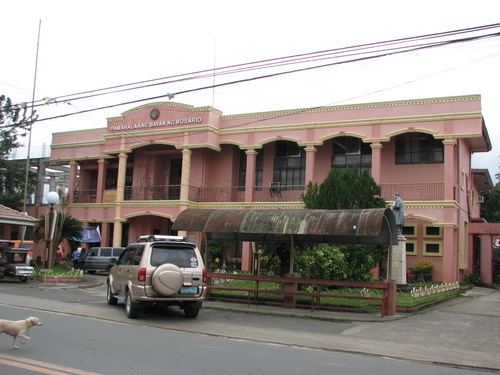Founded 1687 Feast October 7 Local time Thursday 2:36 AM | District 4th District Foundation Day June 9 Area 226.9 km² | |
 | ||
Weather 24°C, Wind E at 2 km/h, 97% Humidity | ||
Rosario, officially the Municipality of Rosario (Filipino: Bayan ng Rosario), is a municipality in the province of Batangas in the Calabarzon (Region IV-A) of the Philippines. The population was 116,764 at the 2015 census. In the 2016 electoral roll, it had 66,441 registered voters.
Contents
- Map of Rosario Batangas Philippines
- Lakbay sarap saya visits the sinublian festival in rosario batangas unang hirit
- History
- Geography
- Barangays
- Clusters
- Demographics
- Government
- Immediate Past Municipal officials
- Notable people
- References
Map of Rosario, Batangas, Philippines
Rosario is considered as among the interior municipalities of the Batangas Bay Region comprising eleven municipalities and two cities whose catchment areas drain into the Batangas Bay. The town is also dubbed as "The Rice Granary of Batangas".
Lakbay sarap saya visits the sinublian festival in rosario batangas unang hirit
History
Accounts show that the origin of Rosario was a Christian settlement along the coast of Lobo. The settlement became prey to the pirate raids during the Moro wars of the 18th century.
The Moro or pirate raids forced the inhabitants of the settlement to the safety of the ravine and forest on the north-west bank of Kansahayan River (now the Municipality of Taysan). Here the settlement was relocated. However, at the height of the Moro Wars in the second half of the 18th century, the vicious Moro raids reached Kansahayan. In one of their forays the Parish Priest is said to be among those slain.
The inhabitants decided to leave Kansahayan. They headed farther north holding a novena and praying the rosary in the process of their flight. On the 9th night of the novena, the fleeing inhabitants reached the river bank of Tubig ng Bayan (a river originating from Lipa) in now the town of Padre Garcia. Here they finally settled. Living in peace and prosperity, the grateful town’s people erected a stone church south of the river bank in honor of their benefactress, the Lady of the Most Holy Rosary Parish. The town was named Santo Rosario.
Santo Rosario was razed to the ground during the Philippine-American War. In the early American military occupation of Santo Rosario, a cavalry officer, Captain Ed H. Boughton, came upon the big spring at the foot of Tombol Hill. He decided to relocate the town west of the spring, where Rosario's population center is now.
Official records show that on June 9, 1902, a council of prominent citizens of the town met under a mango tree beside Tombol Spring. On the spot they formally organized the municipal government of Rosario. The following assumed the first key positions of the town government:
A wealthy landowner, Don Antonio Luansing donated for the town's public buildings and plaza.
Local historians were not unanimous as the exact date of the founding of this town. Certainly it was among those organized by the ecclesiastical authorities after the creation of Batangas as a province in 1581. It is generally believed to have come to the existence in 1687 while still located along the coast of Lobo during the term of Don Nicolas Morales as gobernadorcillo. Originally, Rosario comprised the whole parts of the municipalities of Lobo, Taysan, Ibaan, San Juan de Bolbok and the entire municipality of Padre Garcia.
The old settlement in Kansayahan now bears the name of Pinagbayanan, a thriving marketing post in the municipality of Taysan. The old town site of Santo Rosario had been named Lumang Bayan before it was renamed Padre Garcia when the latter was created and carved out Rosario in 1950 as a separate municipality.
Geography
Rosario is located at 13°50′42″N 121°12′13″E.
According to the Philippine Statistics Authority, the municipality has a land area of 226.88 square kilometres (87.60 sq mi) constituting 7000727000000000000♠7.27% of the 3,119.75-square-kilometre- (1,204.54 sq mi) total area of Batangas.
Barangays
Rosario is politically subdivided into 48 barangays. Malaya was formerly known as Munting Tubig.
Clusters
For purposes of community organization and effective delivery of social development projects, the Office for Sustainable Development under supervision of the Office of the Municipal Mayor in 1995, divided the 48 barangays into 8 barangay clusters with 6 member barangays each.
This system was patterned after the resolutions traditionally passed by the Sangguniang Bayan as part of its organizational plan following the general elections when new members are elected into office for a new term.
Consequently, the barangay cluster arrangement was adopted and served as the framework for land use development strategies enunciated under the Comprehensive Land Use Plan of Rosario, Batangas for Planning Period 2000-2010 (CLUP).
Demographics
In the 2015 census, Rosario had a population of 116,764. The population density was 510 inhabitants per square kilometre (1,300/sq mi).
In the 2016 electoral roll, it had 66,441 registered voters.
Government
The current set of municipal officials were elected during the 2010 General Elections and re-elected in 2013; their term is set to expire in 2016.
Immediate Past Municipal officials
The immediate past municipal officials were elected during the 2004 General Elections and their term expired 2007. The mayor was Felipe Marquez who was reelected for his second term during the 2007 General Elections as chief executive of Rosario. The vice mayor is Danilo Alday. Sangguniang Bayan is composed of Angelica Rosales, Leonardo Anyayahan, Sonia Ebite, Adrian Montalbo, Kennedy Laroza, Pedro Andan and Johnny Minas. Sangguniang Kabataan Municipal Federation President is Grace Villar of Brgy. Quilib.
Mayor Felipe Africa Marquez expired October 8, 2011, while in office, due to various complications in his health at Mediatrix Hospital Lipa City.
